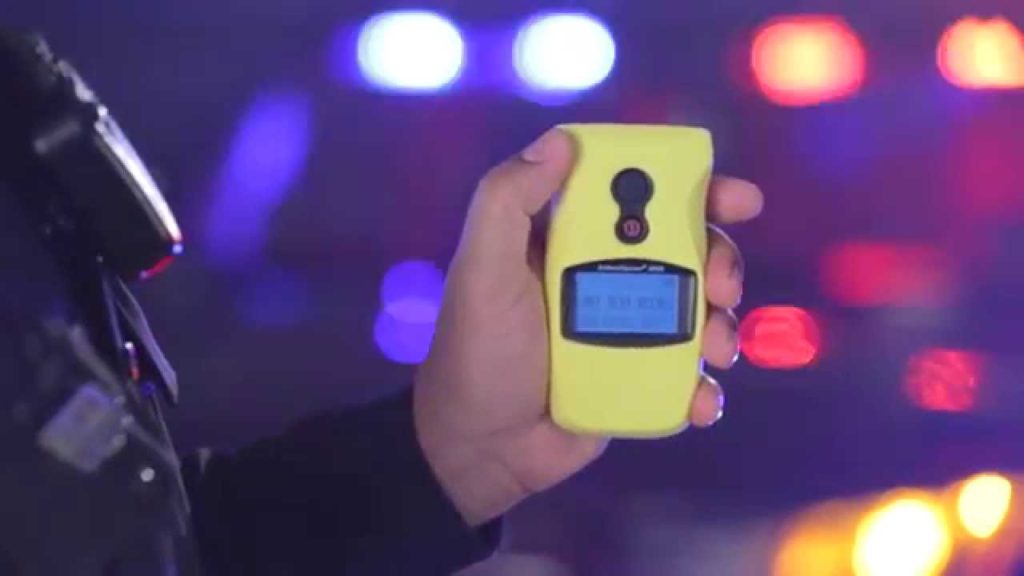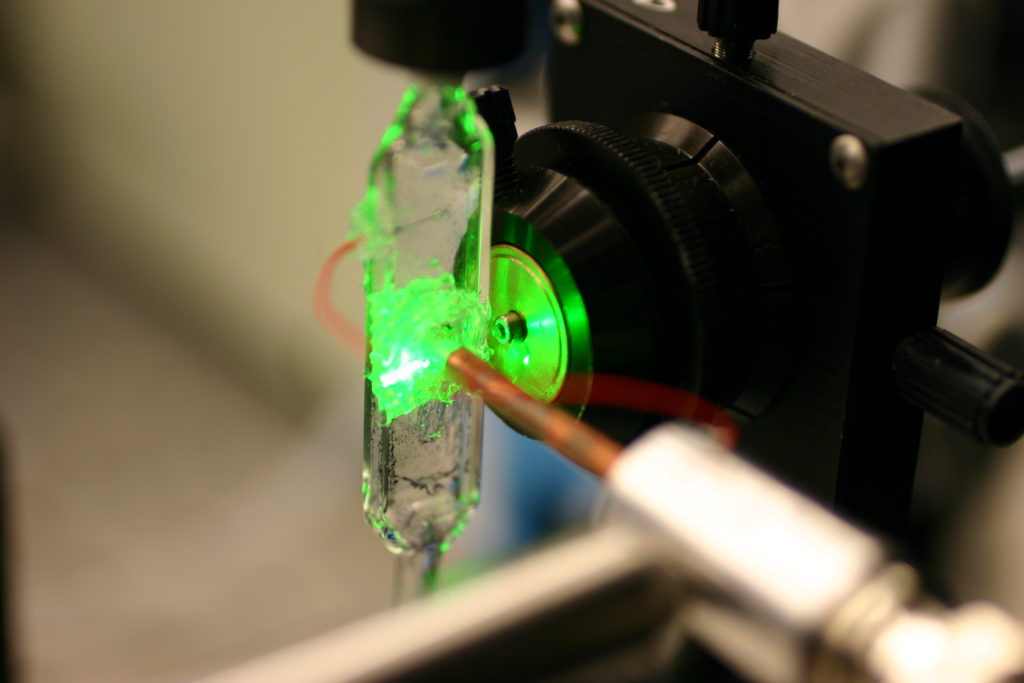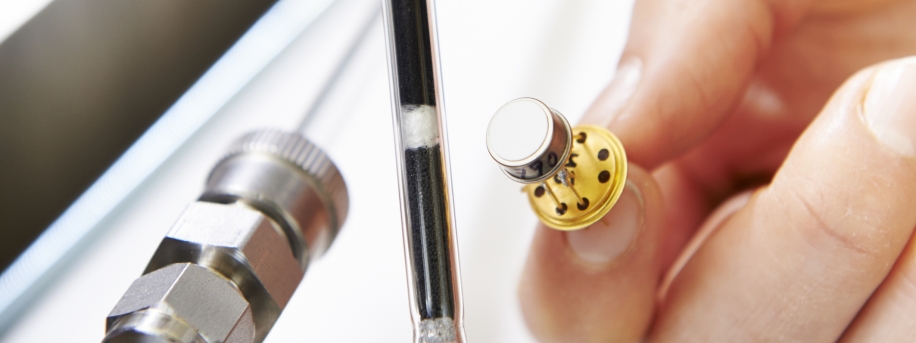
Intoxilyzers are a common example of human breath analysis technology. Courtesy of CMI, Inc.
Introduction to Human Breath Analysis
Linus Pauling discovered modern human breath analysis in 1971 when he demonstrated that human breath has more than 200 different volatile organic compounds, proving breath to be a very complex gas. Human breath contains more than a thousand molecules at varying concentration levels. Each person has a unique breath profile that includes by-products of different metabolic processes. Exhaled molecules serve as biomarkers, or indicators of what is happening within the body. From diagnosing asthma, monitoring weight loss and detecting cancer to police investigation of intoxicated drivers, breath analysis provides a quick and accurate method for medical diagnosis. Current breath-meters on the market utilize laser absorption spectroscopy (LAS) and photoacoustic spectroscopy (PAS) to identify molecular concentrations.
Laser Absorption Spectroscopy
Lasers play an important role in medical diagnostics due to their non-invasive and painless characteristics. They also provide a reusable and cost effective alternative compared to other diagnostic methods, such as blood tests or biopsies, which are commonly invasive, expensive, and time-consuming. LAS – a widely used diagnostics technique – also relies on the non-invasive nature of lasers to characterize a substance based on its peculiar absorption properties. Of the current breath-meters on the market, many employ variations of LAS as their operating principle.
One type of LAS, called tunable laser diode absorption spectroscopy (TDLAS), uses lasers within a specified wavelength range to target specific molecules. Given that gases contain different molecules, specific gases will absorb unique wavelengths of light. The absorption of light through the gas is measured and used to identify various gaseous components. TDLAS is an extremely strong tool with the ability to take highly selective and sensitive measurements of trace gases. Examples of these gases include nitrous oxide, carbon dioxide, and ammonia. In medical diagnostics, identifying the concentration of these molecules in the breath is incredibly helpful for pinpointing health issues. For example, nitrous oxide may indicate asthma, lung inflammation or hypertension, while excessive carbon dioxide concentrations could indicate liver malfunction or bacterial infections within the body.
Infrared (IR) Spectroscopy is another commonly used LAS variation that uses IR wavelengths to excite molecules in a gas. Concentration is again determined by measuring the absorption of the IR light source through a gas sample. Intoxilyzers, frequently used in forensics to identify drunk drivers, utilize IR spectroscopy technology to detect ethanol concentration in the breath. Rapid detection of ethanol allows police officers to incriminate those who are breaking the law.
Photoacoustic Spectroscopy (PAS)
PAS is another breath analysis technology that detects different compounds in gas. The technology is similar to LAS in the sense that it utilizes IR lasers. However, it also combines heat measurement along with optical microscopy. When light hits a sample, photons can either be absorbed, transmitted or reflected. PAS technology focuses on the amount of light absorbed by the gas and the corresponding energy created by excited electrons. This energy is released as heat, creating acoustic waves that are detectable by PAS instruments. The device measures the waves using sensitive microphones and creates a unique acoustic spectrum specific to the sample in question.

Photoacoustic spectroscopy is stable, sensitive and noninvasive. Courtesy of Kurzweil.
PAS is highly sensitive as it can detect gas concentrations below the parts per billion (ppb) and trillion (ppt) level. This technology is used to detect different breath biomarkers including methane, hydrogen sulfide, ethylene and more. These biomarkers correlate to a wide range of health issues, like intestinal problems, bad breath or even ultraviolet radiation damage. Additionally, ammonia breath analyzers also operate using the PAS principle and feature quantum cascade lasers as an IR light emission source. This technology is helpful in the diagnosis of liver failure and abnormal pregnancy.
Improving Medical Diagnostics: The Future of Breath Analysis
The demand for inexpensive and accurate medical diagnostic technology is currently on the rise. The non-invasive and pain-free nature of breath analysis has the potential to improve the current social stigma behind doctors visits and health care testing. Early diagnosis is the key to fighting many diseases, so the ability to quickly and easily test patients is a huge improvement for the medical diagnostics field.

A new human breath analysis technology shows promise in cancer diagnostics. Courtesy of Siemens Corporate Technology.
Many human breath analysis technologies are still in experimental stages, but show promising results in clinical studies. Some of these include cavity ringdown spectroscopy (CRDS), integrated cavity output spectroscopy (ICOS), and optical frequency comb cavity-enhanced absorption spectroscopy (OFC-CEAS). In recent studies, prototypes employing the mentioned technologies have been used to detect type 1 diabetes, lactose and fructose intolerance, organ rejection, and carbon monoxide poisoning. In addition, athletes may soon be able to use gas analysis to monitor acetone, a biomarker correlating to fat loss.
Furthermore, scientists at Siemens Corporate Technology are developing a breath analysis technology to detect the early stages of lung cancer. According the to the American Cancer Society, in 2017, about 222,500 new cases of lung cancer will be diagnosed and about 155,870 of those cases will result in death. However, research also shows that survival rates for most cancers is much higher when diagnosed at an early stage. If breath analysis technology continues to progress at current rates, patients may soon be more likely to visit the doctor and catch cancer in early stages. While this technology still requires much improvement, current research shines light on the possibilities for medical diagnostics in the very near future.
Conclusion
Overall, current breath analysis technologies provide users with a comfortable and quick method for monitoring biological processes within the body. While most applications of breath gas analysis have thus far been in medical fields, the technology also finds several different applications in other areas, including athletics and forensics. Although breath gas analysis is still a relatively new concept, research is progressing quickly and shows impressive results and great promise for future technologies in disease diagnostics.

We, Sensa Bues, use an electrostatic filter to catch aerosols. These small “water”-particles from the bottom of the lungs carry e.g. Illicit Drugs, Stimulants, Therapuetic Drugs, Biomarkers. Commercially available and used in Sweden for Workplace Drug Testing.
After aerosols are collected we use LC-MSMS to detect various non volatiles…